Shaping of HKUST-1 via Extrusion for the Separation of CO2/CH4 in Biogas
Abstract
:1. Introduction
2. Materials and Methods
2.1. Materials
2.2. Shaping of HKUST-1
2.3. Sample Characterization and Gas Adsorption Measurement
- Only a pressure range where N (1 − P/Po) increases monotonically with P/Po should be selected.
- The value of the C constant obtained from the linear regression must be positive.
- The value of relative pressure P/Po, which corresponds to the monolayer loading Nm, must be within the selected pressure range chosen in criterion 1.
- The value of (1/√C + 1) should be equal to the relative pressure determined in criterion 3. (Tolerance up to 20% is suggested by Rouquerol et al. [37].)
2.4. Isosteric Heat of Adsorption
2.5. Prediction of CO2/CH4 Co-Adsorption Isotherm and Selectivity via Ideal Adsorbed Solution Theory (IAST)
2.6. Humidity Ageing Analysis
3. Results and Discussion
3.1. XRD Analysis
3.2. FTIR Analysis
3.3. SEM Analysis
3.4. Thermal Stability Analysis
3.5. Physical Properties and Mechanical Stability Analysis
3.6. CO2/CH4 Adsorption
3.7. Isosteric Heat of Adsorption
3.8. CO2/CH4 Co-Adsorption Isotherm and Selectivity Prediction in Gas Mixture
3.9. Ageing Analysis
4. Conclusions
Supplementary Materials
Author Contributions
Funding
Data Availability Statement
Acknowledgments
Conflicts of Interest
References
- Rafiee, A.; Khalilpour, K.R.; Prest, J.; Skryabin, I. Biogas as an energy vector. Biomass Bioenergy 2021, 144, 105935. [Google Scholar] [CrossRef]
- IEA. Outlook for Biogas and Biomethane: Prospects for Organic Growth. 2020. Available online: https://www.iea.org/reports/outlook-for-biogas-and-biomethane-prospects-for-organic-growth (accessed on 27 July 2023).
- Kapoor, R.; Ghosh, P.; Kumar, M.; Vijay, V.K. Evaluation of biogas upgrading technologies and future perspectives: A review. Environ. Sci. Pollut. Res. 2019, 26, 11631–11661. [Google Scholar] [CrossRef]
- Adnan, A.I.; Ong, M.Y.; Nomanbhay, S.; Chew, K.W.; Show, P.L. Technologies for Biogas Upgrading to Biomethane: A Review. Bioengineering 2019, 6, 92. [Google Scholar] [CrossRef] [PubMed]
- Aghel, B.; Behaein, S.; Wongwises, S.; Shadloo, M.S. A review of recent progress in biogas upgrading: With emphasis on carbon capture. Biomass Bioenergy 2022, 160, 106422. [Google Scholar] [CrossRef]
- Ahmed, S.F.; Mofijur, M.; Tarannum, K.; Chowdhury, A.T.; Rafa, N.; Nuzhat, S.; Kumar, P.S.; Vo, D.-V.N.; Lichtfouse, E.; Mahlia, T.M.I. Biogas upgrading, economy and utilization: A review. Environ. Chem. Lett. 2021, 19, 4137–4164. [Google Scholar] [CrossRef]
- Hosseini, S.S.; Denayer, J.F. Biogas upgrading by adsorption processes: Mathematical modeling, simulation and optimization approach—A review. J. Environ. Chem. Eng. 2022, 10, 107483. [Google Scholar] [CrossRef]
- Rowsell, J.L.; Yaghi, O.M. Metal–organic frameworks: A new class of porous materials. Microporous Mesoporous Mater. 2004, 73, 3–14. [Google Scholar] [CrossRef]
- Furukawa, H.; Cordova, K.E.; O’Keeffe, M.; Yaghi, O.M. The chemistry and applications of metal-organic frameworks. Science 2013, 341, 1230444. [Google Scholar] [CrossRef]
- Li, B.; Wen, H.-M.; Cui, Y.; Zhou, W.; Qian, G.; Chen, B. Emerging multifunctional metal-organic framework materials. Adv. Mater. 2016, 28, 8819–8860. [Google Scholar] [CrossRef]
- Jiao, L.; Seow, J.Y.R.; Skinner, W.S.; Wang, Z.U.; Jiang, H.-L. Metal–organic frameworks: Structures and functional applications. Mater. Today 2019, 27, 43–68. [Google Scholar] [CrossRef]
- Deyun, M.; Li, Z.; Zhu, J.; Zhou, Y.; Chen, L.; Mai, X.; Liufu, M.; Wu, Y.; Li, Y. Inverse and highly selective separation of CO2/C2H2 on a thulium—Organic framework. J. Mater. Chem. A 2020, 8, 11933–11937. [Google Scholar]
- Letong, L.; Zou, J.; Han, Y.; Liao, Z.; Lu, P.; Nezamzadeh-Ejhieh, A.; Liu, J.; Peng, Y. Recent advances in Al (iii)/In (iii)-based MOFs for the detection of pollutants. New J. Chem. 2022, 46, 19577–19592. [Google Scholar]
- Saha, D.; Bao, Z.; Jia, F.; Deng, S. Adsorption of CO2, CH4, N2O, and N2 on MOF-5, MOF-177, and zeolite 5A. Environ. Sci. Technol. 2010, 44, 1820–1826. [Google Scholar] [CrossRef] [PubMed]
- Ding, M.; Flaig, R.W.; Jiang, H.-L.; Yaghi, O.M. Carbon capture and conversion using metal-organic frameworks and MOF-based materials. Chem. Soc. Rev. 2019, 48, 2783–2828. [Google Scholar] [CrossRef] [PubMed]
- Abid, H.R.; Hanif, A.; Keshavarz, A.; Shang, J.; Iglauer, S. CO2, CH4, and H2 Adsorption Performance of the Metal–Organic Framework HKUST-1 by Modified Synthesis Strategies. Energy Fuels 2023, 37, 7260–7267. [Google Scholar] [CrossRef]
- Salehi, S.; Anbia, M.; Razavi, F. Improving CO2/CH4 and CO2/N2 adsorptive selectivity of Cu-BTC and MOF-derived nanoporous carbon by modification with nitrogen-containing groups. Environ. Prog. Sustain. Energy 2020, 39, 13302. [Google Scholar] [CrossRef]
- Teo, H.W.B.; Chakraborty, A.; Kayal, S. Evaluation of CH4 and CO2 adsorption on HKUST-1 and MIL-101(Cr) MOFs employing Monte Carlo simulation and comparison with experimental data. Appl. Therm. Eng. 2017, 110, 891–900. [Google Scholar] [CrossRef]
- Asadi, T.; Ehsani, M.R.; Ribeiro, A.M.; Loureiro, J.M.; Rodrigues, A.E. CO2/CH4 Separation by Adsorption using Nanoporous Metal organic Framework Copper-Benzene-1, 3, 5-tricarboxylate Tablet. Chem. Eng. Technol. 2017, 36, 1231–1239. [Google Scholar] [CrossRef]
- Ediati, R.; Dewi, S.K.; Hasan, M.R.; Kahardina, M.; Murwani, I.K.; Nadjib, M. Mesoporous HKUST-1 synthesized using solvothermal method. Rasayan J. Chem. 2019, 12, 1653–1659. [Google Scholar] [CrossRef]
- Morales, E.M.C.; Méndez-Rojas, M.A.; Torres-Martínez, L.M.; Garay-Rodríguez, L.F.; López, I.; Uflyand, I.E.; Kharisov, B.I. Ultrafast synthesis of HKUST-1 nanoparticles by solvothermal method: Properties and possible applications. Polyhedron 2021, 210, 115517. [Google Scholar] [CrossRef]
- Nobar, S.N. Cu-BTC synthesis, characterization and preparation for adsorption studies. Mater. Chem. Phys. 2018, 213, 343–351. [Google Scholar] [CrossRef]
- Guo, L.; Du, J.; Li, C.; He, G.; Xiao, Y. Facile synthesis of hierarchical micro-mesoporous HKUST-1 by a mixed-linker defect strategy for enhanced adsorptive removal of benzothiophene from fuel. Fuel 2021, 300, 120955. [Google Scholar] [CrossRef]
- Armstrong, M.; Sirous, P.; Shan, B.; Wang, R.; Zhong, C.; Liu, J.; Mu, B. Prolonged HKUST-1 functionality under extreme hydrothermal conditions by electrospinning polystyrene fibers as a new coating method. Microporous Mesoporous Mater. 2018, 270, 34–39. [Google Scholar] [CrossRef]
- Vehrenberg, J.; Vepsäläinen, M.; Macedo, D.; Rubio-Martinez, M.; Webster, N.A.; Wessling, M. Steady-state electrochemical synthesis of HKUST-1 with polarity reversal. Microporous Mesoporous Mater. 2020, 303, 110218. [Google Scholar] [CrossRef]
- Vepsäläinen, M.; Macedo, D.S.; Gong, H.; Rubio-Martinez, M.; Bayatsarmadi, B.; He, B. Electrosynthesis of HKUST-1 with Flow-Reactor Post-Processing. Appl. Sci. 2021, 11, 3340. [Google Scholar] [CrossRef]
- Liu, P.; Zhao, T.; Cai, K.; Chen, P.; Liu, F.; Tao, D.-J. Rapid mechanochemical construction of HKUST-1 with enhancing water stability by hybrid ligands assembly strategy for efficient adsorption of SF6. Chem. Eng. J. 2022, 437, 135364. [Google Scholar] [CrossRef]
- Tomislav, T.; Batzdorf, L.; Lukin, S.; Žilić, C.; Motillo, C.; Fris, T.; Emmerling, F.; Halasz, I.; Užarević, K. In situ monitoring of the mechanosynthesis of the archetypal metal–organic framework HKUST-1: Effect of liquid additives on the milling reactivity. Inorg. Chem. 2017, 56, 6599–6608. [Google Scholar]
- Ren, J.; Langmi, H.W.; North, B.C.; Mathe, M. Review on processing of metal-organic framework (MOF) materials towards system integration for hydrogen storage. Int. J. Energy Res. 2015, 39, 607–620. [Google Scholar] [CrossRef]
- Ryu, U.; Jee, S.; Rao, P.C.; Shin, J.; Ko, C.; Yoon, M.; Park, K.S.; Choi, K.M. Recent advances in process engineering and upcoming applications of metal–organic frameworks. Coord. Chem. Rev. 2021, 426, 213544. [Google Scholar] [CrossRef]
- Liu, X.-M.; Xie, L.-H.; Wu, Y. Recent advances in the shaping of metal-organic frameworks. Inorg. Chem. Front. 2020, 7, 2840–2866. [Google Scholar] [CrossRef]
- Mallick, A.; Mouchaham, G.; Bhatt, P.M.; Liang, W.; Belmabkhout, Y.; Adil, K.; Jamal, A.; Eddaoudi, M. Advances in Shaping of Metal-Organic Frameworks for CO2 Capture: Understanding the Effect of Rubbery and Glassy Polymeric Binders. Ind. Eng. Chem. Res. 2018, 57, 16897–16902. [Google Scholar] [CrossRef]
- Ma, Q.; Zhang, T.; Wang, B. Shaping of metal-organic frameworks, a critical step toward industrial applications. Matter 2022, 5, 1070–1091. [Google Scholar] [CrossRef]
- Li, Y.; Wen, G.; Li, J.; Li, Q.; Zhang, H.; Tao, B.; Zhang, J. Synthesis and shaping of metal-organic frameworks: A review. Chem. Commun. 2022, 58, 11488–11506. [Google Scholar] [CrossRef] [PubMed]
- Hong, W.Y.; Perera, S.P.; Burrows, A.D. Manufacturing of metal-organic framework monoliths and their application in CO2 adsorption. Microporous Mesoporous Mater. 2015, 214, 149–155. [Google Scholar] [CrossRef]
- Gerardo, M.; Pérez-Ramírez, J. Scalable room-temperature conversion of copper (II) hydroxide into HKUST-1 (Cu3(btc)2). Adv. Mater. 2013, 25, 1052–1057. [Google Scholar]
- Jean, R.; Rouquerol, F.; Llewellyn, P.; Maurin, G.; Sing, K. Adsorption by Powders and Porous Solids: Principles, Methodology and Applications; Academic Press: Cambridge, MA, USA, 2013. [Google Scholar]
- Khabzina, Y.; Dhainaut, J.; Ahlhelm, M.; Richter, H.-J.; Reinsch, H.; Stock, N.; Farrusseng, D. Synthesis and Shaping Scale-up Study of Functionalized UiO-66 MOF for Ammonia Air Purification Filters. Ind. Eng. Chem. Res. 2018, 57, 8200–8208. [Google Scholar] [CrossRef]
- Myers, A.L.; Prausnitz, J.M. Thermodynamics of mixed-gas adsorption. AIChE J. 1965, 11, 121–127. [Google Scholar] [CrossRef]
- Lee, S.; Lee, J.H.; Kim, J. User-friendly graphical user interface software for ideal adsorbed solution theory calculations. Korean J. Chem. Eng. 2018, 35, 214–221. [Google Scholar] [CrossRef]
- Xiu, D.; Cao, Y.; Shi, X.; Wang, X. Non-isothermal crystallization kinetics, thermal degradation behavior and mechanical properties of poly (lactic acid)/MOF composites prepared by melt-blending methods. RSC Adv. 2016, 6, 71461–71471. [Google Scholar]
- da Silva, F.W.M.; Magalhães, G.M.; de Oliveira Jardim, E.; Silvestre-Albero, J.; Sepúlveda-Escribano, A.; de Azevedo, D.C.S.; de Lucena, S.M.P. CO2 adsorption on ionic liquid—Modified Cu-BTC: Experimental and simulation study. Adsorp. Sci. Technol. 2015, 33, 223–242. [Google Scholar] [CrossRef]
- Denning, S.; Majid, A.A.; Lucero, J.M.; Crawford, J.M.; Carreon, M.A.; Koh, C.A. Metal-Organic Framework HKUST-1 Promotes Methane Hydrate Formation for Improved Gas Storage Capacity. ACS Appl. Mater. Interfaces 2020, 12, 53510–53518. [Google Scholar] [CrossRef] [PubMed]
- González, S.; Edwin, A.; Olmos, D.; Lorente, M.Á.; Vélaz, I.; González-Benito, J. Preparation and characterization of polymer composite materials based on PLA/TiO2 for antibacterial packaging. Polymers 2018, 10, 1365. [Google Scholar] [CrossRef] [PubMed]
- Li, Y.; Miao, J.; Sun, X.; Xiao, J.; Li, Y.; Wang, H.; Xia, Q.; Li, Z. Mechanochemical synthesis of Cu-BTC@GO with enhanced water stability and toluene adsorption capacity. Chem. Eng. J. 2016, 298, 191–197. [Google Scholar] [CrossRef]
- Feng, Y.; Jiang, H.; Li, S.; Wang, J.; Jing, X.; Wang, Y.; Chen, M. Metal-organic frameworks HKUST-1 for liquid-phase adsorption of uranium. Colloids Surfaces A Physicochem. Eng. Asp. 2013, 431, 87–92. [Google Scholar] [CrossRef]
- Singbumrung, K.; Motina, K.; Pisitsak, P.; Chitichotpanya, P.; Wongkasemjit, S.; Inprasit, T. Preparation of Cu-BTC/PVA Fibers with Antibacterial Applications. Fibers Polym. 2018, 19, 1373–1378. [Google Scholar] [CrossRef]
- Nivetha, R.; Sajeev, A.; Paul, A.M.; Gothandapani, K.; Gnanasekar, S.; Bhardwaj, P.; Jacob, G.; Sellappan, R.; Raghavan, V.; Chandar, N.K.; et al. Cu based Metal Organic Framework (Cu-MOF) for electrocatalytic hydrogen evolution reaction. Mater. Res. Express 2020, 7, 114001. [Google Scholar] [CrossRef]
- Gwardiak, S.; Szczęśniak, B.; Choma, J.; Jaroniec, M. Benzene adsorption on synthesized and commercial metal–organic frameworks. J. Porous Mater. 2019, 26, 775–783. [Google Scholar] [CrossRef]
- Evans, K.A.; Kennedy, Z.C.; Arey, B.W.; Christ, J.F.; Schaef, H.T.; Nune, S.K.; Erikson, R.L. Chemically Active, Porous 3D-Printed Thermoplastic Composites. ACS Appl. Mater. Interfaces 2018, 10, 15112–15121. [Google Scholar] [CrossRef]
- Mu, X.; Chen, Y.; Lester, E.; Wu, T. Optimized synthesis of nano-scale high quality HKUST-1 under mild conditions and its application in CO2 capture. Microporous Mesoporous Mater. 2018, 270, 249–257. [Google Scholar] [CrossRef]
- Chen, Y.; Mu, X.; Lester, E.; Wu, T. High efficiency synthesis of HKUST-1 under mild conditions with high BET surface area and CO2 uptake capacity. Prog. Nat. Sci. 2018, 28, 584–589. [Google Scholar] [CrossRef]
- Shah, B.B.; Kundu, T.; Zhao, D. Mechanical Properties of Shaped Metal-Organic Frameworks. Top. Curr. Chem. 2019, 377, 25. [Google Scholar] [CrossRef] [PubMed]
- Kriesten, M.; Schmitz, J.V.; Siegel, J.; Smith, C.E.; Kaspereit, M.; Hartmann, M. Shaping of Flexible Metal-Organic Frameworks: Combining Macroscopic Stability and Framework Flexibility. Eur. J. Inorg. Chem. 2019, 2019, 4700–4709. [Google Scholar] [CrossRef]
- Zheng, J.; Cui, X.; Yang, Q.; Ren, Q.; Yang, Y.; Xing, H. Shaping of ultrahigh-loading MOF pellet with a strongly anti-tearing binder for gas separation and storage. Chem. Eng. J. 2018, 354, 1075–1082. [Google Scholar] [CrossRef]
- Grande, C.A.; Águeda, V.I.; Spjelkavik, A.; Blom, R. An efficient recipe for formulation of metal-organic Frameworks. Chem. Eng. Sci. 2015, 124, 154–158. [Google Scholar] [CrossRef]
- Cavenati, S.; Grande, C.A.; Rodrigues, A.E. Adsorption Equilibrium of Methane, Carbon Dioxide, and Nitrogen on Zeolite 13X at High Pressures. J. Chem. Eng. Data 2004, 49, 1095–1101. [Google Scholar] [CrossRef]
- Cessford, N.F.; Seaton, N.A.; Düren, T. Evaluation of Ideal Adsorbed Solution Theory as a Tool for the Design of Metal-Organic Framework Materials. Ind. Eng. Chem. Res. 2012, 51, 4911–4921. [Google Scholar] [CrossRef]
- Youn-Sang, B.; Mulfort, K.L.; Frost, H.; Ryan, P.; Punnathanam, S.; Broadbelt, L.J.; Hupp, J.T.; Snurr, R.Q. Separation of CO2 from CH4 using mixed-ligand metal-organic frameworks. Langmuir 2008, 24, 8592–8598. [Google Scholar]
- Billemont, P.; Heymans, N.; Normand, P.; De Weireld, G. IAST predictions vs co-adsorption measurements for CO2 capture and separation on MIL-100 (Fe). Adsorption 2017, 23, 225–237. [Google Scholar] [CrossRef]
- Heymans, N.; Vaesen, S.; De Weireld, G. A complete procedure for acidic gas separation by adsorption on MIL-53 (Al). Microporous Mesoporous Mater. 2014, 154, 93–99. [Google Scholar] [CrossRef]
- Gholipour, F.; Mofarahi, M. Adsorption equilibrium of methane and carbon dioxide on zeolite 13X: Experimental and thermodynamic modeling. J. Supercrit. Fluids 2016, 111, 47–54. [Google Scholar] [CrossRef]
- Garshasbi, V.; Jahangiri, M.; Anbia, M. Equilibrium CO2 adsorption on zeolite 13X prepared from natural clays. Appl. Surf. Sci. 2017, 393, 225–233. [Google Scholar] [CrossRef]
- Wu, H.; Simmons, J.M.; Srinivas, G.; Zhou, W.; Yildirim, T. Adsorption Sites and Binding Nature of CO2 in Prototypical Metal-Organic Frameworks: A Combined Neutron Diffraction and First-Principles Study. J. Phys. Chem. Lett. 2010, 1, 1946–1951. [Google Scholar] [CrossRef]
- Supronowicz, B.; Mavrandonakis, A.; Heine, T. Interaction of Small Gases with the Unsaturated Metal Centers of the HKUST-1 Metal Organic Framework. J. Phys. Chem. C 2013, 117, 14570–14578. [Google Scholar] [CrossRef]
- Zhao, Y.; Ge, H.; Miao, Y.; Chen, J.; Cai, W. CO2 capture ability of Cu-based metal-organic frameworks synergized with amino acid-functionalized layered materials. Catal. Today 2020, 356, 604–612. [Google Scholar] [CrossRef]
- Al-Janabi, N.; Hill, P.; Torrente-Murciano, L.; Garforth, A.; Gorgojo, P.; Siperstein, F.; Fan, X. Mapping the Cu-BTC metal-organic framework (HKUST-1) stability. Chem. Eng. J. 2015, 281, 669–677. [Google Scholar] [CrossRef]
- Terracinaa, A.; Buscarino, G. Water Stability of Metal-Organic Framework HKUST-1. Gen. Chem. 2021, 7, 210002. [Google Scholar] [CrossRef]
- Xue, W.; Zhang, Z.; Huang, H.; Zhong, C.; Mei, D. Theoretical Insights into the Initial Hydrolytic Breakdown of HKUST-1. J. Phys. Chem. C 2019, 124, 1991–2001. [Google Scholar] [CrossRef]
- Michela, T.; Alessi, A.; Luisa, S.; Simonpietro, A.; Marco, C.; Franco, G.; Gianpiero, B. Investigation by Raman Spectroscopy of the Decomposition Process of HKUST-1 upon Exposure to Air. J. Spectrosc. 2016, 2016, 8074297. [Google Scholar]
- Kohlheb, N.; Wluka, M.; Bezama, A.; Thrän, D.; Aurich, A.; Müller, R.A. Environmental-Economic Assessment of the Pressure Swing Adsorption Biogas Upgrading Technology. BioEnergy Res. 2021, 14, 901–909. [Google Scholar] [CrossRef]
- Koonaphapdeelert, S.; Aggarangsi, P.; Moran, J. Biogas Upgrading, in Biomethane. In Green Energy and Technology; Springer: Singapore, 2020; pp. 47–98. [Google Scholar]

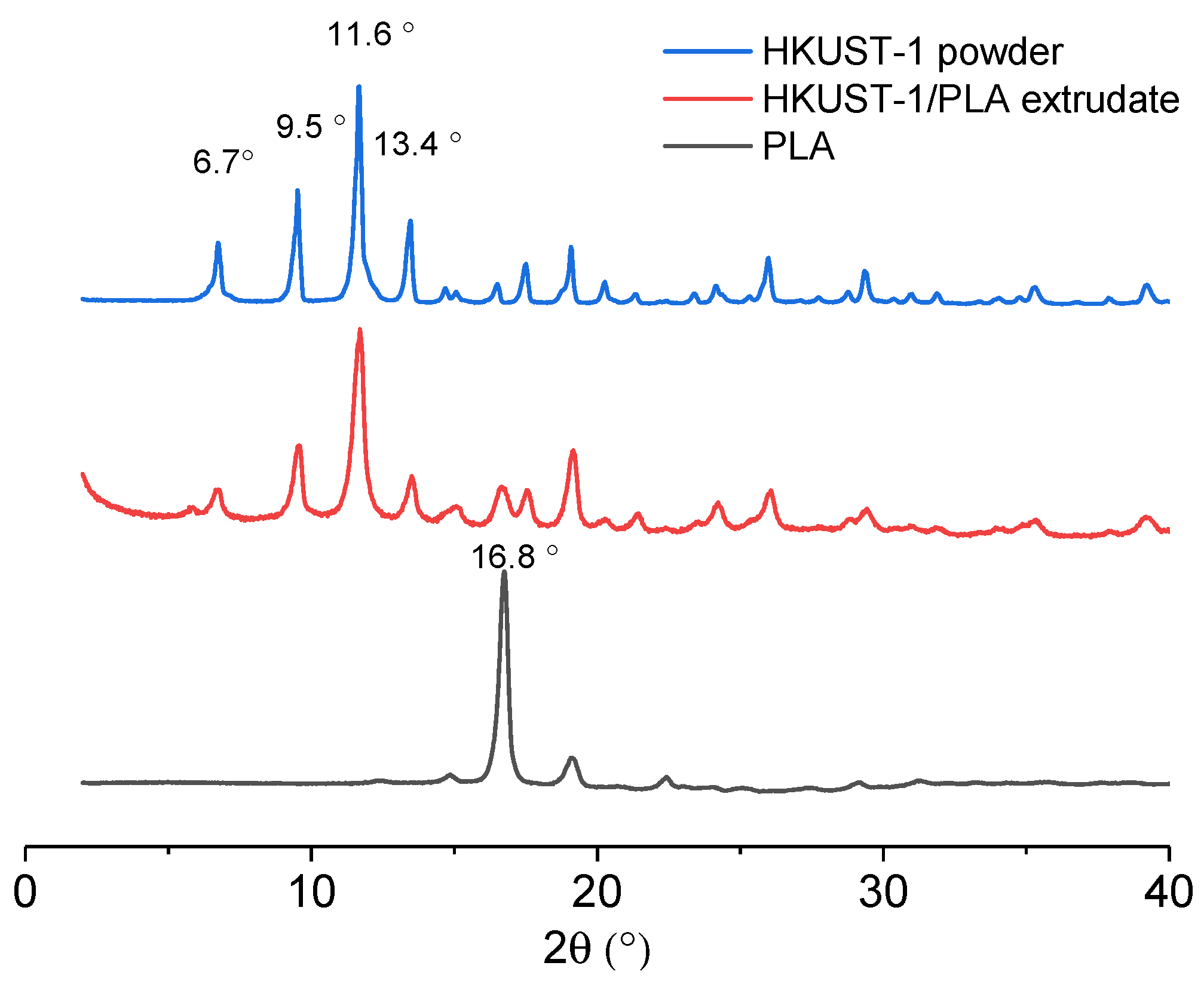
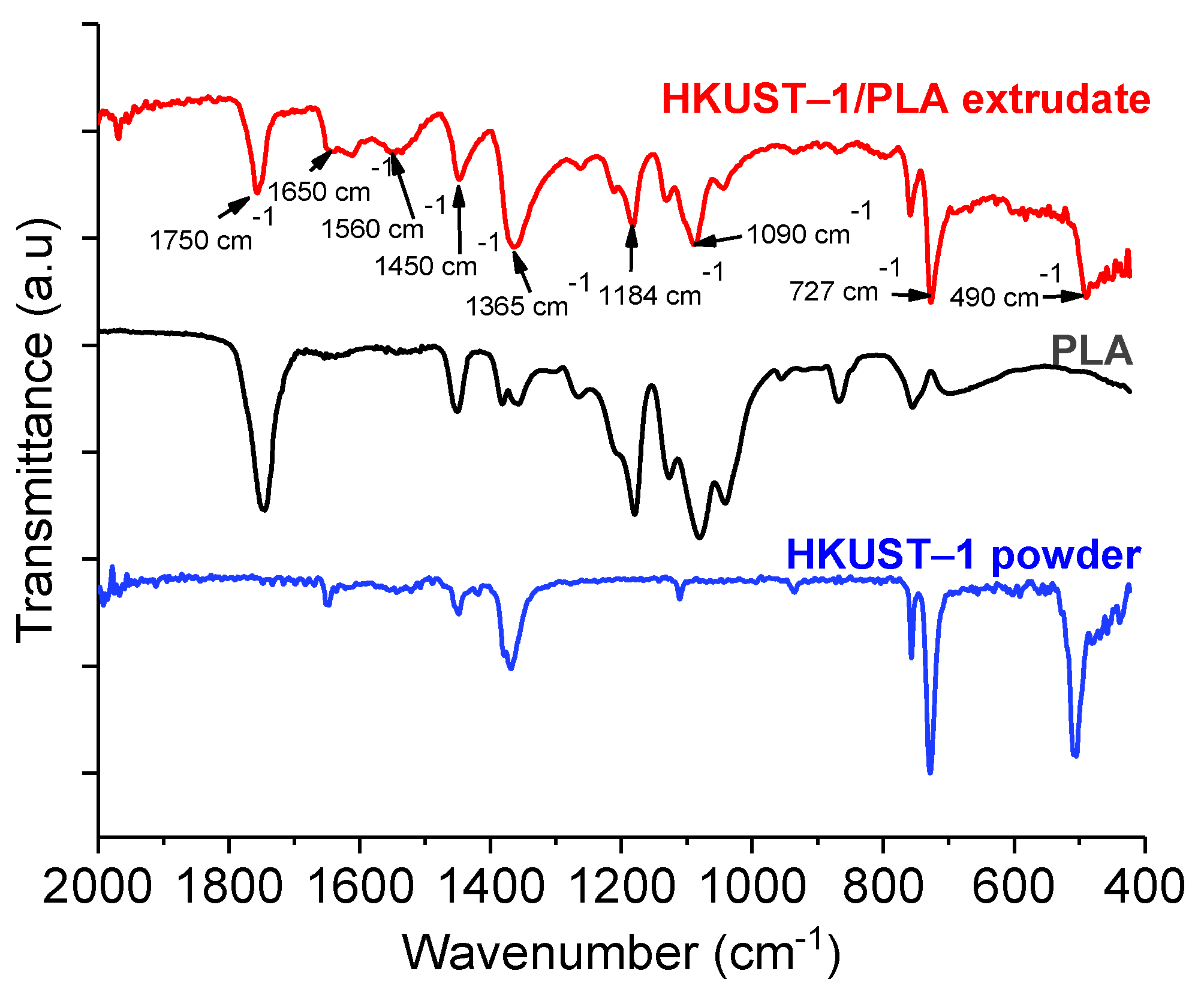
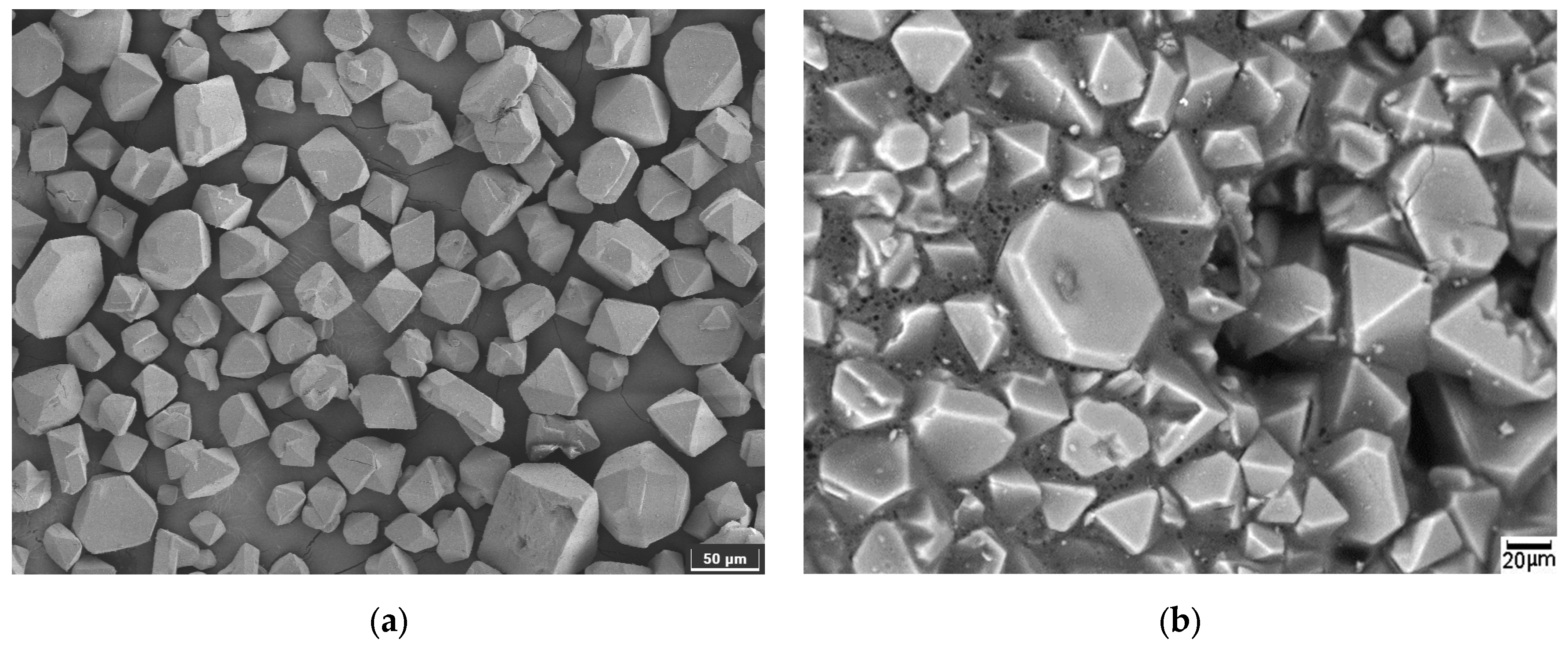
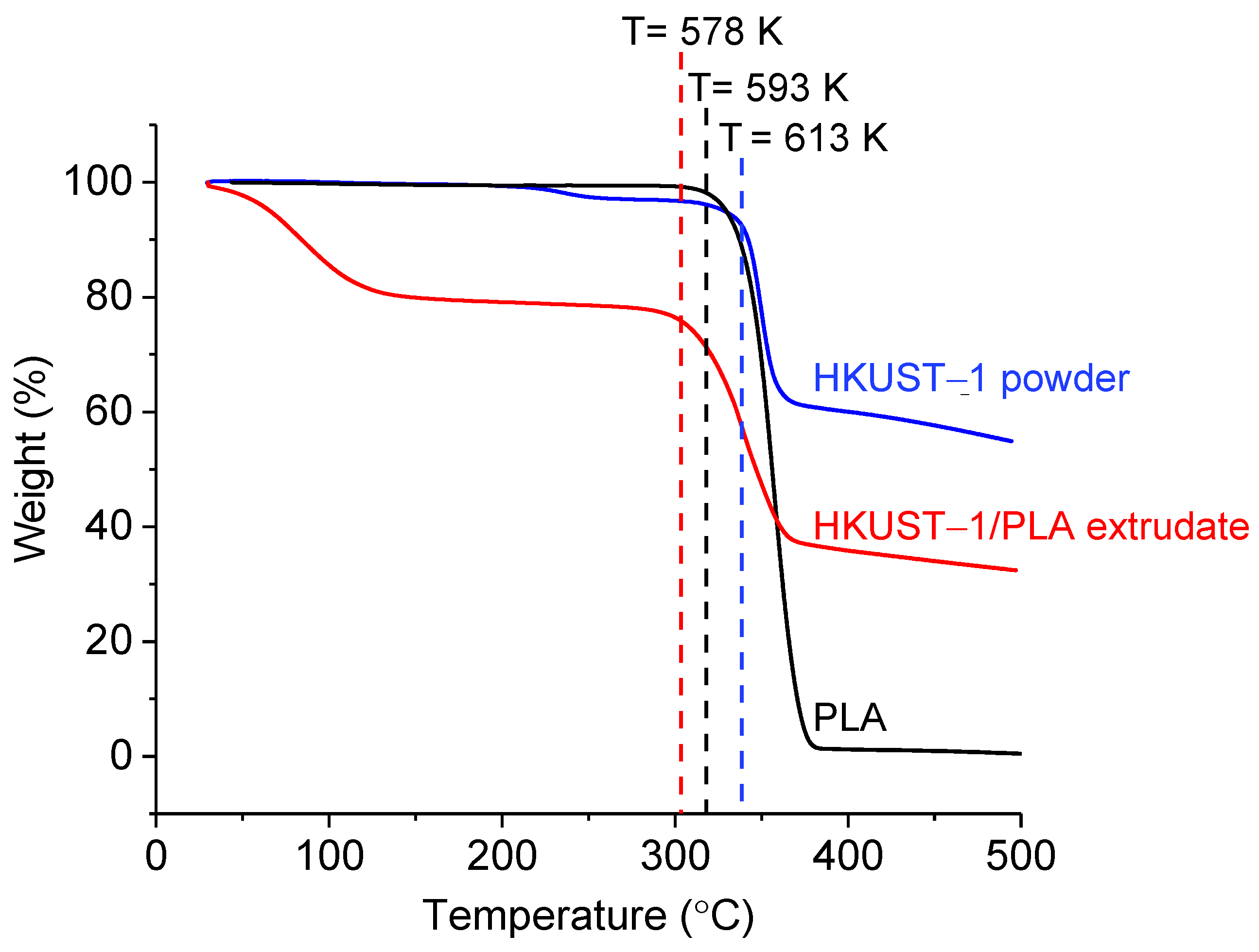





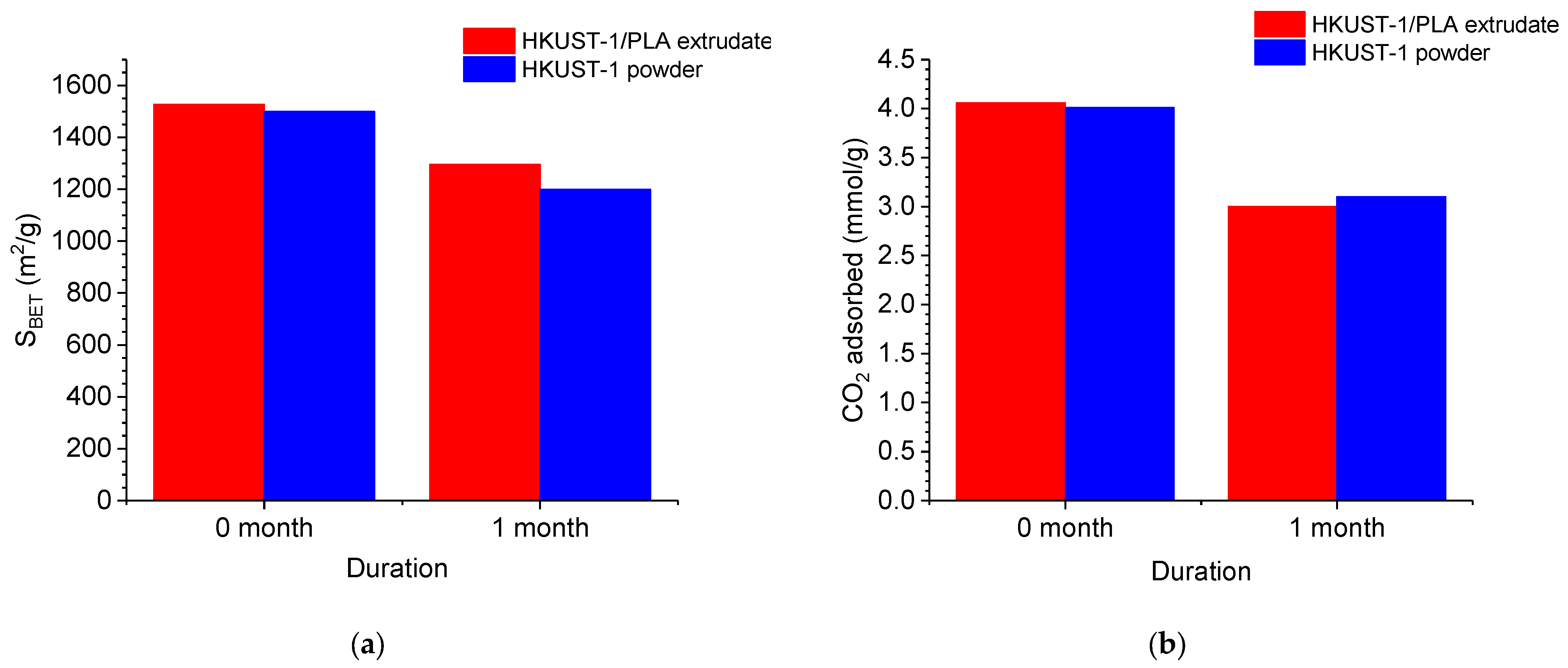
| Sample | SBET (m2/g) | Micropore Volume (cm3/g), (a) | Total Pore Volume (cm3/g), (b) |
|---|---|---|---|
| HKUST-1 powder | 1500 | 0.46 | 0.65 |
| HKUST-1/PLA extrudate | 1528 | 0.54 | 0.65 |
| Washed HKUST-1 powder | 1956 | 0.60 | 0.79 |
| Sample | Attrition Loss (% wt) | Reference |
|---|---|---|
| HKUST-1/PLA extrudate | 0.5 | This work |
| 3A | 0.2 | [53] |
| 4A | 0.2 | |
| 5A | 0.2 | |
| 13X | 0.2 | |
| AC-Norit RZN1 | 0.2 | [38] |
| UiO-66 extrudate | 1.4 |
| Adsorbent | Binding Agent | Binding Agent Loading (wt.%) | Shaped MOF Adsorption Capacity (mmol/g) | Parent MOF Adsorption Capacity (mmol/g) | Reference |
|---|---|---|---|---|---|
| HKUST-1 | Polylactic acid (PLA) | 10 | 4.06 | 4.01 | This work |
| MIL-53 (Al) | Methyl cellulose | 3 | 2.60 | 2.60 | [54] |
| HKUST-1 | Polyvinyl butyral (PVB) | 10 | 4.88 | 5.18 | [55] |
| UTSA-16 | Polyvinyl alcohol (PVA) | 0.7 | 3.83 | 4.20 | [56] |
| Mil-101 (Cr) | Bentonite clay | 40 | 0.59 | 1.06 | [35] |
| HKUST-1 Powder | HKUST-1/PLA Extrudate | |||
|---|---|---|---|---|
| CO2 | CH4 | CO2 | CH4 | |
| q1,i (mmol/g) | 7.6819 | 0.693639 | 11.8369 | 3.97862 |
| q2,i (mmol/g) | 4.57812 | 16.0057 | 3.49004 | 117.582 |
| K1,i (MPa−1) | 4.24177 | 7.8488 | 3.2608 | 1.07153 |
| K2,i (MPa−1) | 4.24177 | 0.2778 | 3.2608 | 0.02949 |
| R2 | 0.9999 | 0.9999 | 0.9999 | 0.9999 |
Disclaimer/Publisher’s Note: The statements, opinions and data contained in all publications are solely those of the individual author(s) and contributor(s) and not of MDPI and/or the editor(s). MDPI and/or the editor(s) disclaim responsibility for any injury to people or property resulting from any ideas, methods, instructions or products referred to in the content. |
© 2023 by the authors. Licensee MDPI, Basel, Switzerland. This article is an open access article distributed under the terms and conditions of the Creative Commons Attribution (CC BY) license (https://creativecommons.org/licenses/by/4.0/).
Share and Cite
Rozaini, M.T.; Grekov, D.I.; Bustam, M.A.; Pré, P. Shaping of HKUST-1 via Extrusion for the Separation of CO2/CH4 in Biogas. Separations 2023, 10, 487. https://doi.org/10.3390/separations10090487
Rozaini MT, Grekov DI, Bustam MA, Pré P. Shaping of HKUST-1 via Extrusion for the Separation of CO2/CH4 in Biogas. Separations. 2023; 10(9):487. https://doi.org/10.3390/separations10090487
Chicago/Turabian StyleRozaini, Muhamad Tahriri, Denys I. Grekov, Mohamad Azmi Bustam, and Pascaline Pré. 2023. "Shaping of HKUST-1 via Extrusion for the Separation of CO2/CH4 in Biogas" Separations 10, no. 9: 487. https://doi.org/10.3390/separations10090487
APA StyleRozaini, M. T., Grekov, D. I., Bustam, M. A., & Pré, P. (2023). Shaping of HKUST-1 via Extrusion for the Separation of CO2/CH4 in Biogas. Separations, 10(9), 487. https://doi.org/10.3390/separations10090487






